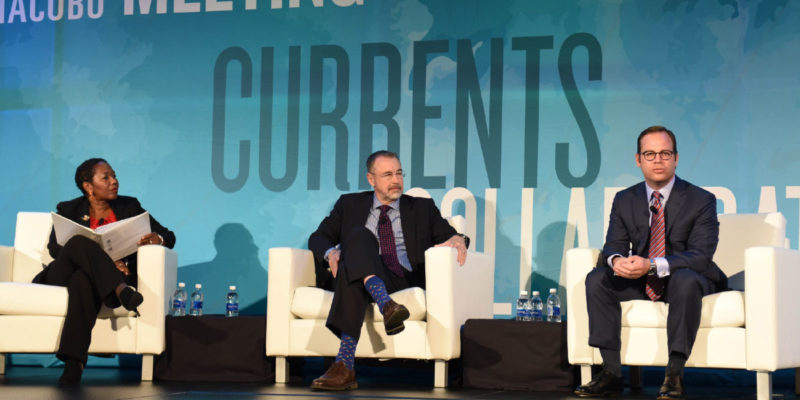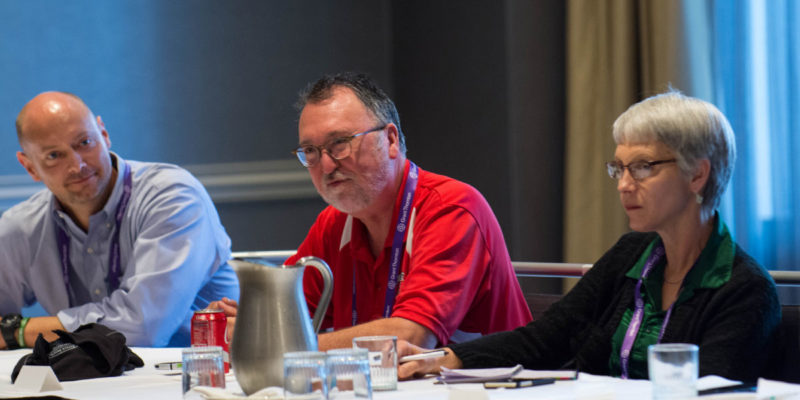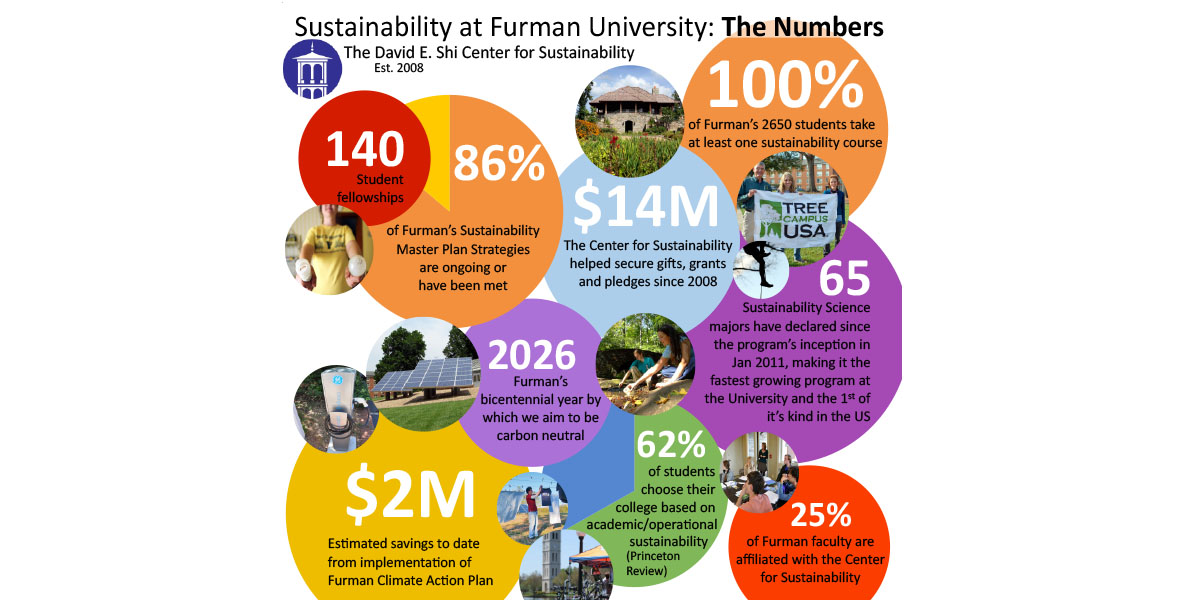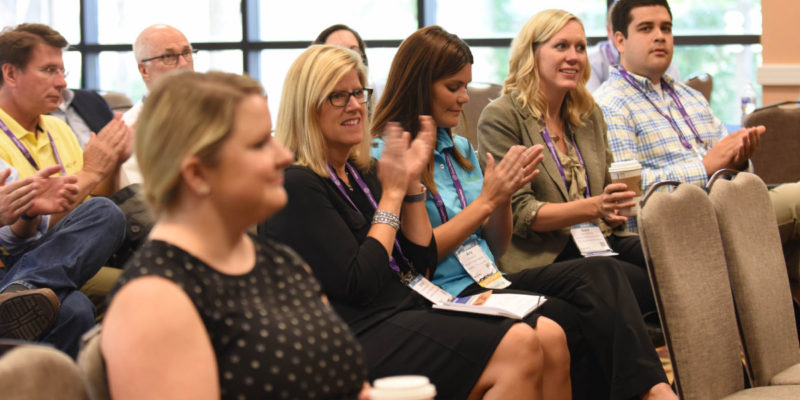
The Art and Science of Storytelling

While higher education has long been widely viewed as a solid pathway to good employment, in more recent years, many lawmakers have instead been hearing stories from their voting constituencies of graduates struggling to find good jobs in the aftermath of the Great Recession, or of ever-rising costs of attendance and alarming levels of student debt. So, how can college and university leaders best communicate the value of postsecondary education at a time when the American public’s view regarding the cost-benefit of higher education has taken a hit?
Panelists during a featured luncheon on the topic of “Reaffirming the Public Trust in Higher Education” spoke of the need for higher education leaders to tell stories that reflect the good work of their institutions. Joy Brathwaite, vice president for finance and chief financial officer, Minneapolis College of Art and Design, moderated the conversation between Matt Salmon, retired congressman (Arizona-5th District) and vice president for government affairs at Arizona State University, and J. Cliff Johnson III, practice leader, National Journal’s Leadership Council, which works with government affairs and public policy organizations to help them become more efficient.
Salmon’s Suggestions
When you consider the diversity of activity and programming taking place across any given campus, there is something for everyone to connect with, argued Salmon. Key is to find what resonates with individual congressional leaders and then get them to your campus to show them the impact of what you’re doing and how it improves opportunities for people. You will find support, but you have to work hard at this, warned Salmon.
And, don’t forget that congressional leaders also are looking at the bottom line, so be proactive not only in tailoring messages, but also explaining how a particular program or project contributes to jobs and competitiveness. The urgency behind this push to be out front with messaging is that if you aren’t effectively telling your story, an alternate story will emerge, said Salmon.
Johnson’s Formula for Success
Johnson argued that human brains are hardwired for storytelling that adheres to a certain narrative structure. In this regard, storytelling is more of a science. For instance, a good story provides some level of conflict, since without that tension, people may lose interest or ignore your message. Likewise, most of us recall the first thing and last thing said, so these points should be especially memorable, noted Johnson. You also need to provide some sort of resolution to the conflict.
Yet, storytelling must not only make an intellectual connection, but also connect to the heart, argued Johnson. Data appeals to the mind, but the emotion of a story is what appeals to the heart and carries the listener over the finish line. When communicating with lawmakers, college and university leaders need to determine how to persuade lawmakers and staffers with both the details of a policy agenda and the characters who can help make the agenda relatable. Is it the story of a military family member, an industry worker, or a first-generation student? Think in terms of relaying their stories to help frame your agenda. Having a variety of stories on hand will allow you to appeal to different leaders with whom you must discuss your agenda, said Johnson.
Other storytelling tips:
- In an advocacy context, don’t forget to make an actual ask, pairing data and story.
- Make sure your story represents the big picture. If your example is too specific, the response may be to try to solve the issue for that individual case rather than for the sector as a whole, noted Johnson.
- Your stories are very likely already out there, but they often get stuck in your donor relations or development office, like the level of tuition discounting your institution provides, or the number of jobs a particular degree program produces. Find these stories and frame them for your various congressional leaders.
KARLA HIGNITE, New York City, is a contributing editor for Business Officer.
Helping Students Decrease Debt

As institutions continue to look for ways to help students decrease debt, Purdue University, West Lafayette, Ind., introduced in 2015 an option called income sharing agreements (ISAs).
Such options are needed because:
- Federal aid and loan limits are not increasing at the rates of tuition increase.
- Tuition discount rates are at an all-time high and institutions are unable to fully meet student needs.
- There is an increase in defaults on student and parent loans.
In the session “A New Approach to Education Affordability: Income Sharing Agreements,” speakers Mary Claire Cartwright, vice president, information technology, Purdue Research Foundation, and Pete Ugo, partner, Crowe Horwath LLP, discussed the ways Purdue University offers ISAs.
How an ISA Works
An ISA is an alternative to a student loan and is a contractual agreement in which a student receives education funding from an institution in exchange for an agreed-upon percentage of postgraduation income over a defined number of years.
An ISA differs from a student loan because there is no fixed repayment amount or an outstanding balance, Ugo said. Payments vary based on income level and there is no use of an interest rate. Students aren’t accruing interest on the total amount funded, but most will pay back more than the principal borrowed. The success of the investment fund is tied to students’ incomes.
Purdue University is offering ISAs to sophomores, juniors, and seniors who need to finance their education with private or parent PLUS loans after exhausting the use of all scholarship, grants, and federal loans, Cartwright said. It’s also suited to those students who value the ISA’s postgraduation income downside protection, while also being comfortable with the ISA’s postgraduation income upside payment capped at 2.5 times the education funding amount.
ISA payments adjust according to levels of income, Cartwright said. Additionally, there is a minimum income threshold and a maximum payment cap, so students who use the program will not pay if they do not meet a minimum income level, while those who earn a substantial amount of income will not pay above a certain maximum amount.
One risk the students may face is that the amount of payment is based on income, so if a student commits to an ISA and earns a high income after graduation, then he or she may pay more to the investment fund than the student would have with conventional debt. However, Purdue Research Foundation caps the total amount paid at 2.5 times the education funding amount received from the investment fund.
Demystifying the Myths
In recent times, several arguments have been made against ISAs, with one of them being that such a funding alternative is not needed. Purdue views its ISAs as an alternative to private and parent PLUS student loans, and not as a requirement, Cartwright said. On the other hand, the institution considers its ISA offering as being consistent with the Purdue objective of delivering higher education at the highest proven value, she said.
While some believe that ISAs may drive students away from their area of interest toward high-income producing majors, Cartwright said that Purdue believes it is sound for each student to consider the economics of acquiring a university degree, including the cost of education and financing, and postgraduation income expectations.
The institution offers ISAs to all Purdue majors and not just those students who have majors with the highest expected postgraduation incomes, she said.
PREETI VASISHTHA is deputy editor for Business Officer.
Energy Efficiency on Display

NACUBO Annual Meeting attendees had opportunity to study the 44 Campus Efficiencies Posters prominently on display in the convention center, featuring a range of financial and environmental solutions implemented at colleges and universities across the nation. Poster topics ran the gamut, from major physical plant and utility infrastructure improvements to organic composting. Among the 2017 poster highlights:
- University of California San Diego integrated procure-to-pay solutions.
- Brandman University student accounts metrics and collections system.
- Colorado College net zero library renovation.
- Augsburg College collaborative student sustainability leadership development program with a major state university, a nonprofit college, and two community colleges.
- Johnson County Community College sustainability initiatives fund.
- University of Alabama comprehensive energy management plan.
- Of these, the projects at UC San Diego, Brandman University, and Colorado College were honored with the 2017 NACUBO Innovation Award.

Campus posters have been an annual meeting staple since 2014 and continue to expand in popularity as a means to share success stories in a visual format. (The deadline to register to display a poster for the NACUBO 2018 Annual Meeting, in Long Beach, Calif., is Jan. 31, 2018.) If you didn’t make it to Minneapolis, you can still tap the wealth of good ideas shared. Posters from the 2014 to 2017 annual meetings are archived on the NACUBO web site at www.nacubo.org.
Also, more than 50 attendees took part in NACUBO’s Sustainability Advisory Panel roundtable discussion focused on campus resources and needs, sharing ideas about effective policies and procedures surrounding a variety of issues, including energy sourcing and financing.
Long-term Cost Savings

Utilities represent one of the largest nonpayroll operating costs for most higher education institutions. The roughly 4,100 colleges and universities across the country account for an annual sectorwide energy spend of approximately $6 billion to $7 billion, according to Chris O’Brien, director of higher education programs for Edison Energy, and one of the presenters of the session “Controlling Long-Term Energy Costs With Renewable Energy Purchase Agreements.”
Large-scale renewables are a growing share of that spend, in part due to the lower costs of wind and solar. Other factors include federal tax credits and portfolio standards that have supported sector growth, and institution sustainability commitments and climate action plans that have motivated many colleges and universities to reduce their energy-related greenhouse gas emissions. Even within regulated markets, a pent-up interest for large-scale renewable energy projects is in some cases producing creative workarounds, suggested O’Brien.
As of 2014, more than 120 higher education campuses had invested in on-site solar, accounting for about 1,500 Kwh of power production per campus on average. A much greater opportunity exists for off-site solar, argued O’Brien. Of the large-scale off-site solar projects in which higher education institutions participated in 2014, production on average exceeded 32 Mwh. With thousands of off-site projects potentially available for colleges and universities to find partners, solar power purchase agreements (PPAs) are emerging as a compelling way for campuses to hedge against the uncertain long-term costs of conventional or brown power, said O’Brien.
Howard University is in the beginning stages of exploring an off-site solar project. In the meantime, the university is implementing a multifaceted on-site project that includes rooftop arrays and solar parking canopies. According to Howard’s CFO and Treasurer Michael Masch, co-presenter of the session, energy management for the university adheres to three primary requirements: focus on conservation, reduce costs and risk, and leverage outside funding sources wherever possible. The university already has experience entering public-private partnerships related to student housing and IT infrastructure projects, so leveraging investment in an off-site solar power purchase agreement holds very real potential, noted Masch.
According to O’Brien, while many of the initial off-site PPAs within the higher education sector have involved larger research universities, market opportunities are now such that even smaller institutions can find viable partners for their needs. And, those opportunities should remain within a growing U.S. solar marketplace that today employs five times more workers than the U.S. coal industry, noted O’Brien. For more on PPAs, see the NACUBO on-demand webcast “Containing Cost and Risk With Renewables: The Power Purchase Agreement Story.”
KARLA HIGNITE, New York City, is a contributing editor for Business Officer.



